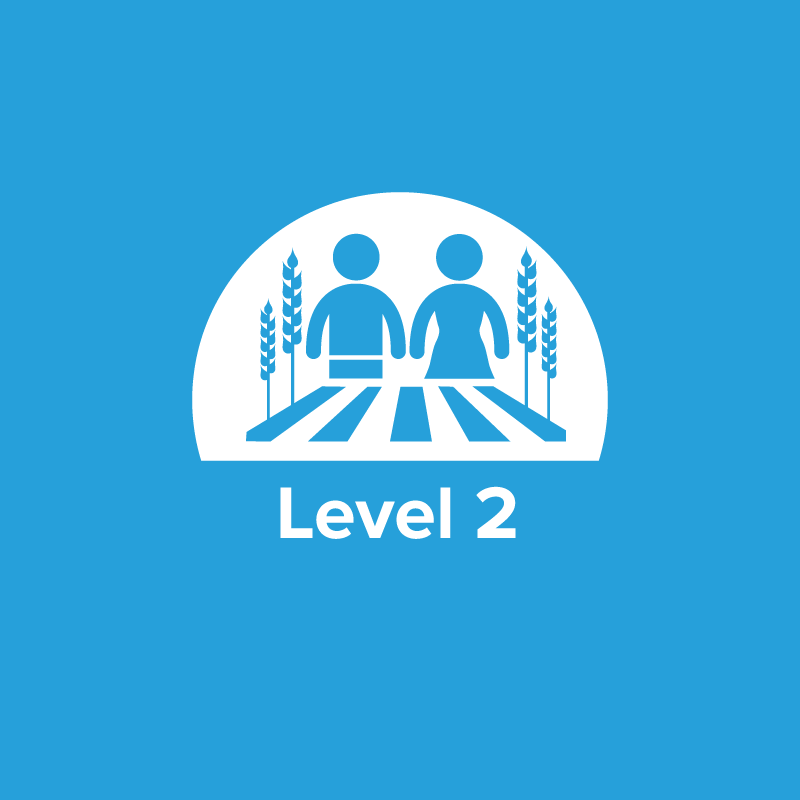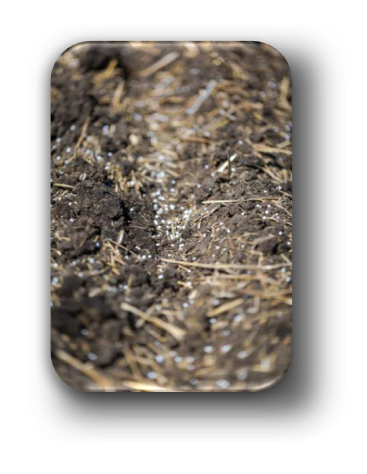Journey 2050 Lesson 2: Soil Nutrients (Grades 6-8)
Students will identify nitrogen, potassium and phosphorus as primary soil nutrients necessary in the production of abundant and healthy foods, describe various methods of replenishing soil nutrients that have been depleted by plant growth, discover how overall plant health impacts a plant’s ability to resist disease and pests and describe what best management practices are in agriculture to improve overall sustainability.

Background
Lesson Activities
Recommended Companion Resources
Credits
Author
Lindsey Verhaeghe, Andrea Gardner, Debra Spielmaker, and Sara Hunt | National Center for Agricultural Literacy (NCAL) and Nutrien
Acknowledgements
The Journey 2050 program was originally developed by Nutrien in collaboration with Calgary Stampede, Alberta Canola Producers Commission, Nutrients for Life Foundation, and Agriculture in the Classroom Canada. Authors and contributors were drawn from each of these organizations under the direction of Lindsey Verhaeghe (Nutrien) and Robyn Kurbel (Calgary Stampede.) The lessons were updated and revised in 2017 and 2022 with contributions from the original J2050 Steering Committee, the National Center for Agricultural Literacy, and the National Agriculture in the Classroom Organization.
Sources
- https://en.wikipedia.org/wiki/Bushel
- https://wagrains.org/wheat/
- https://www.ers.usda.gov/webdocs/publications/41880/33132_ah697_002.pdf
- https://en.wikipedia.org/wiki/Acre
- http://www.scidev.net/sub-saharan-africa/agriculture/news/fertile-soil-increases-crop-yields.html
- https://www.topcropmanager.com/the-role-of-fertilizer-in-growing-the-worlds-food-10387/
Standards
Texas Content Area Standards
-
Principles of Agriculture, Food, and Natural Resources: 130.2.c.1
The student demonstrates professional standards/employability skills as required by business and industry. The student is expected to:
- Principles of Agriculture, Food, and Natural Resources: 130.2.c.1.B: apply competencies related to resources, information, interpersonal skills, problem solving, critical thinking, and systems of operation in agriculture, food, and natural resources.
-
Principles of Agriculture, Food, and Natural Resources: 130.2.c.4
The student explains the historical, current, and future significance of the agriculture, food, and natural resources industry. The student is expected to:
- Principles of Agriculture, Food, and Natural Resources: 130.2.c.4.B: analyze the scope of agriculture, food, and natural resources and its effect upon society.
- Principles of Agriculture, Food, and Natural Resources: 130.2.c.4.C: evaluate significant historical and current agriculture, food, and natural resources developments.
- Principles of Agriculture, Food, and Natural Resources: 130.2.c.4.F: compare and contrast issues impacting agriculture, food, and natural resources such as biotechnology, employment, safety, environment, and animal welfare issues.
- Principles, of Agriculture, Food, and Natural Resources: 130.2.c.4.D: identify potential future scenarios for agriculture, food, and natural resources systems, including global impacts.
-
Principles of Agriculture, Food, and Natural Resources: 130.2.c.6
The student demonstrates appropriate personal and communication skills. The student is expected to:
- Principles of Agriculture, Food, and Natural Resources: 130.2.c.6.A: demonstrate written and oral communication skills appropriate for formal and informal situations such as prepared and extemporaneous presentations.
- Principles of Agriculture, Food, and Natural Resources: 130.2.c.6.B: demonstrate effective listening skills appropriate for formal and informal situations.
-
Principles of Agriculture, Food, and Natural Resources: 130.2.c.10
The student develops technical knowledge and skills related to soil systems. The student is expected to:
- Principles of Agriculture, Food, and Natural Resources: 130.2.c.10.A: identify the components and properties of soils.
-
ELA: 7.110.23.b.5
Comprehension skills: listening, speaking, reading, writing, and thinking using multiple texts. The student uses metacognitive skills to both develop and deepen comprehension of increasingly complex texts.
- ELA: 7.110.23.b.5.H: synthesize information to create new understanding
-
Science: 6.112.26.b.1
Scientific and engineering practices. The student, for at least 40% of instructional time, asks questions, identifies problems, and plans and safely conducts classroom, laboratory, and field investigations to answer questions, explain phenomena, or design solutions using appropriate tools and models. The student is expected to:
- Science: 6.112.26.b.1.A: ask questions and define problems based on observations or information from text, phenomena, models, or investigations
-
Science: 6.112.26.b.3
Scientific and engineering practices. The student develops evidence-based explanations and communicates findings, conclusions, and proposed solutions. The student is expected to:
- Science: 6.112.26.b.3.A: develop explanations and propose solutions supported by data and models and consistent with scientific ideas, principles, and theories;
-
Science: 6.112.26.b.5
Recurring themes and concepts. The student understands that recurring themes and concepts provide a framework for making connections across disciplines. The student is expected to:
- Science: 6.112.26.b.5.A: identify and apply patterns to understand and connect scientific phenomena or to design solutions;
-
Science: 6.112.26.b.10
Earth and space. The student understands the rock cycle and the structure of Earth. The student is expected to:
- Science: 6.112.26.b.10.A: differentiate between the biosphere, hydrosphere, atmosphere, and geosphere and identify components of each system;
-
Science: 6.112.26.b.11
Earth and space. The student understands how resources are managed. The student is expected to:
- Science: 6.112.26.b.11.B: explain how conservation, increased efficiency, and technology can help manage air, water, soil, and energy resources.
-
Science: 6.112.26.b.12
Organisms and environments. The student knows that interdependence occurs between living systems and the environment. The student is expected to:
- Science: 6.112.26.b.12.A: investigate how organisms and populations in an ecosystem depend on and may compete for biotic factors such as food and abiotic factors such as availability of light and water, range of temperatures, or soil composition;
-
Science: 7.112.27.b.1
Scientific and engineering practices. The student, for at least 40% of instructional time, asks questions, identifies problems, and plans and safely conducts classroom, laboratory, and field investigations to answer questions, explain phenomena, or design solutions using appropriate tools and models. The student is expected to:
- Science: 7.112.27.b.1.A: ask questions and define problems based on observations or information from text, phenomena, models, or investigations;
-
Science: 7.112.27.b.3
Scientific and engineering practices. The student develops evidence-based explanations and communicates findings, conclusions, and proposed solutions. The student is expected to:
- Science: 7.112.27.b.3.A: develop explanations and propose solutions supported by data and models and consistent with scientific ideas, principles, and theories;
-
Science: 7.112.27.b.5
Recurring themes and concepts. The student understands that recurring themes and concepts provide a framework for making connections across disciplines. The student is expected to:
- Science: 7.112.27.b.5.A: identify and apply patterns to understand and connect scientific phenomena or to design solutions;
-
Science: 8.112.28.b.1
Scientific and engineering practices. The student, for at least 40% of instructional time, asks questions, identifies problems, and plans and safely conducts classroom, laboratory, and field investigations to answer questions, explain phenomena, or design solutions using appropriate tools and models. The student is expected to:
- Science: 8.112.28.b.1.A: ask questions and define problems based on observations or information from text, phenomena, models, or investigations;
-
Science: 8.112.28.b.3
Scientific and engineering practices. The student develops evidence-based explanations and communicates findings, conclusions, and proposed solutions. The student is expected to:
- Science: 8.112.28.b.3.A: develop explanations and propose solutions supported by data and models and consistent with scientific ideas, principles, and theories;
-
Science: 8.112.28.b.5
Recurring themes and concepts. The student understands that recurring themes and concepts provide a framework for making connections across disciplines. The student is expected to:
- Science: 8.112.28.b.5.A: identify and apply patterns to understand and connect scientific phenomena or to design solutions;
-
Science: 8.112.28.b.12
Organisms and environments. The student understands stability and change in populations and ecosystems. The student is expected to:
- Science: 8.112.28.b.12.A: explain how disruptions such as population changes, natural disasters, and human intervention impact the transfer of energy in food webs in ecosystems;
- Science: 8.112.28.b.12.B: describe how primary and secondary ecological succession affect populations and species diversity after ecosystems are disrupted by natural events or human activity; and
- Science: 8.112.28.b.12.C: describe how biodiversity contributes to the stability and sustainability of an ecosystem and the health of the organisms within the ecosystem.
-
ELA: 6.110.22.b.5
Comprehension skills: listening, speaking, reading, writing, and thinking using multiple texts. The student uses metacognitive skills to both develop and deepen comprehension of increasingly complex texts. The student is expected to:
- ELA: 6.110.22.b.5.H: synthesize information to create new understanding
-
ELA: 8.110.24.b.5
Comprehension skills: listening, speaking, reading, writing, and thinking using multiple texts. The student uses metacognitive skills to both develop and deepen comprehension of increasingly complex texts. The student is expected to:
- ELA: 8.110.24.b.5.H: synthesize information to create new understanding
 Plants require 17 essential nutrients. The primary nutrients are nitrogen (N), phosphorus (P) and potassium (K). Each nutrient does many things for the plant but the basics are these:
Plants require 17 essential nutrients. The primary nutrients are nitrogen (N), phosphorus (P) and potassium (K). Each nutrient does many things for the plant but the basics are these: